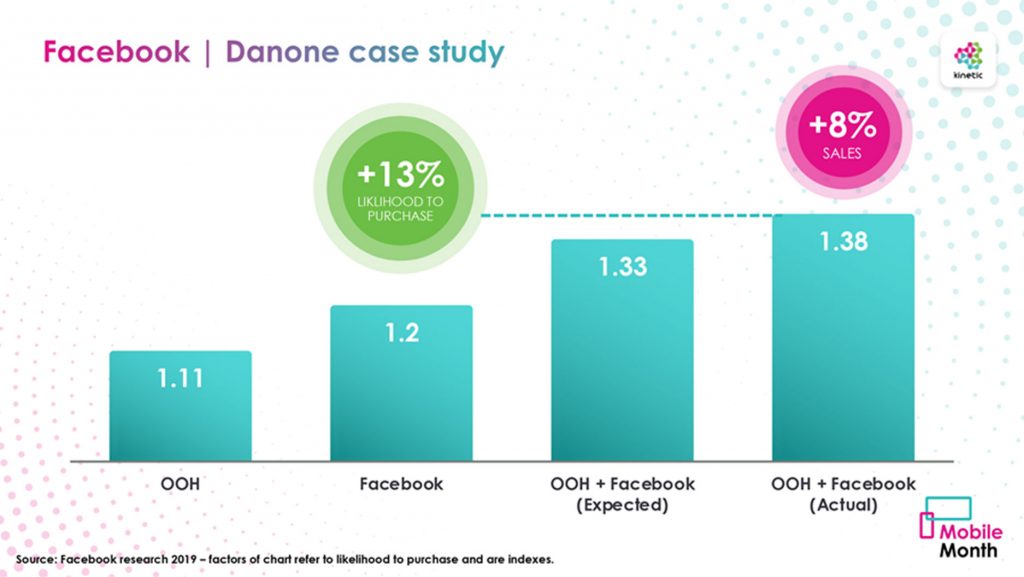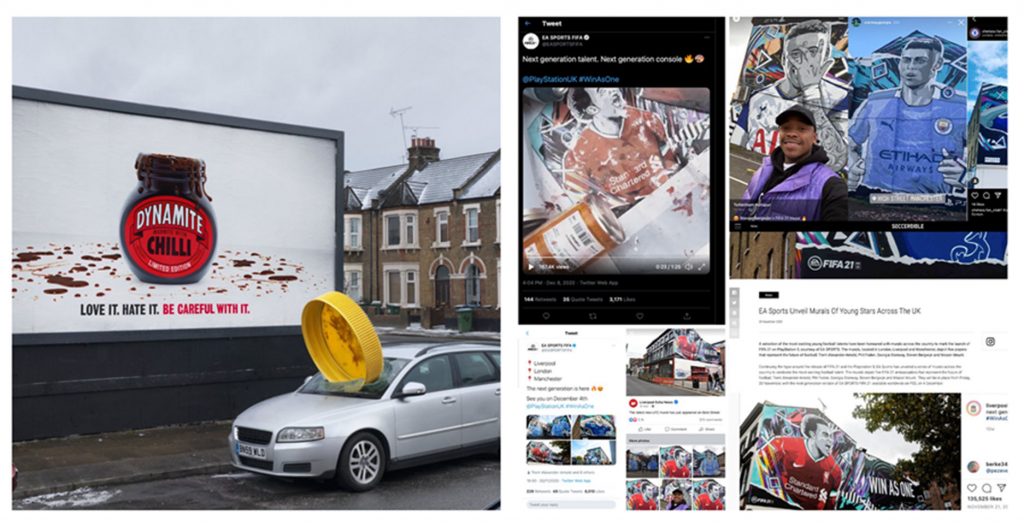The complementary relationship between OOH and mobile has been accelerated during the pandemic, giving brands access to more creative and targeted opportunities than ever before. Our Chief Client Officer Nicole Lonsdale takes a look.
Recent investment in digital OOH, data, tech and automation means OOH can now target audiences more accurately than ever before. And with mobile phones increasingly intrinsic to all aspects of our lives, particularly when outdoors, OOH has become a powerful trigger for a range of online behaviours.
A study of IPA effectiveness campaigns by Peter Field found that having OOH as part of the media plan boosted the performance of other channels, including search by a massive 54%. OOH can be the trigger for Mcommerce too, something that has been heighted during Covid. Many DTC brands have long understood the power OOH has as a public, reach-driving media channel – a virtual shopfront if you will – ensuring their brand is kept top of mind prior to purchase.

Over the past five years there’s been a growing trend of commuter (or Outdoor) commerce, where people shop on their phones while out and about – usually during high dwell-time moments while travelling to and from work or socialising. Our Commuter Commerce research conducted with Global and the CEBR showed the annual value of commuter commerce in 2019 was £22.8bn. With just under half of people making 4+ purchases a month on their commutes.
And while this has seen a dip during Covid, over 63% of the working population (20 million) are now regularly travelling to their place of work. This will continue to increase as the year progresses, and with the prevalence of mobile devices and on-board Wi-Fi, OOH advertising is primed to trigger a purchase in the moment.
But the relationship between OOH and Mobile extends way beyond this.
How to deliver better outcomes by actively combining OOH + Mobile
Immediate targeting – Achieve synchronicity of viewing and increase frequency by geofencing an OOH campaign so that a mobile display ad is also served within that immediate area and time. This makes both channels work harder to cement the advertising message in people’s minds.
Adding coverage – Fill any gaps in reach by serving a mobile display ad to those not exposed to OOH.
Retargeting – reach a consumer when they are more likely to act on a message by serving a mobile display message to people exposed to OOH at a later time or date. This could be in proximity to store or perhaps when they’re at home.
When OOH is combined with social is when the partnership really comes to life. Both over-index against a younger 18-34 year old audience. And both use soundless, short-form video. Content can be easily lifted from social and displayed on full-motion DOOH screens and our Journeys platform can plan using replicated social audiences (behavioural or based upon social media usage), to seamlessly (and programmatically) extend the reach of social content in the real world.
A recent Facebook study demonstrated how OOH and social are ‘better together’. The research for Danone showed that likelihood to purchase for those exposed to both OOH and social increased by +13% and actual sales by +8%.

Richer content and creativity
OOH is often seen as the home of creativity, but mobile can enhance this too.
Making OOH go viral!
Impactful and engaging OOH can drive earned media. The global ECD of Spotify was quoted as saying “OOH is a form of social media, which when executed well, can connect with a far greater audience online”. During Covid this has never been truer, with many OOH campaigns being tactically executed to go viral.
Some recent examples include Electronic Arts’ launch of FIFA 21 that used content capturing the creation of murals of up-and-coming football players to deliver 1.9m engagements organically on social, and Marmite’s infamous Dynamite campaign that used three special builds to create 194m social impressions.

A portal to content
Smartphone cameras can unlock layers of information, utility, entertainment and commerce through OOH. The pandemic has educated all ages on how to scan codes easily and this has already been embraced by media and creative agencies who’ve been incorporating more codes and AR experiences with OOH than ever before.
Last month, Ben & Jerry’s launched its Peace Pops with a stunning OOH creative incorporating a snapcode, that when scanned transports the consumer to a festival experience via a lens. Klarna included QR codes on exquisitely designed murals to create a myth-busting treasure hunt on its financial payment offering. And most recently Campari partnered with Affordable Art Fair to create “Art without walls” – the UK’s largest outdoor art gallery. QR codes on each OOH creative allowed consumers to view and purchase artwork directly.

Location-based mobile experiences layered over the real world can drive tangible results too. Burger King ran a campaign in Brazil to raise awareness of their app. Consumers were invited to “burn” Burger King’s competitor’s billboard via AR, to turn it into an ad for Burger King themselves. The gamification proved popular with 400,000 ads burned, one million app downloads in a month and a whopping 56% increase of in-app sales.
Smarter planning and measurement
Mobile data is intrinsic to media planning across channels, but it has revolutionised OOH over the past 18 months. Through Journeys, our behavioural planning platform, we can use the same audiences as digital channels, allowing us to activate DOOH programmatically. And this data is anonymised and aggregated meaning its GDPR compliant and not reliant upon cookies.
Journeys’ SDK data has been our holy grail during Covid providing us with near real-time insights into changing audience behaviour and mobility. Fusing the data with Route has allowed us to plan smarter – optimising campaigns and selecting the environments and frames that deliver the most impacts for our clients.
Mobile SDK data also provides a new means of measuring the outcomes of an OOH campaign, identifying who has been exposed and then tracking their footfall to store, website visitation or serving them with a brand uplift study.
The relationship between OOH and Mobile will continue to evolve with the roll out of 5G, the opportunities created by AR, and the growth of frictionless and social commerce.
At Kinetic we’ve just completed Mobile Month, a series of virtual training sessions to upskill our planners on all things OOH and Mobile. All would agree that the future looks rosy.
For more information get in touch with your Kinetic contact.